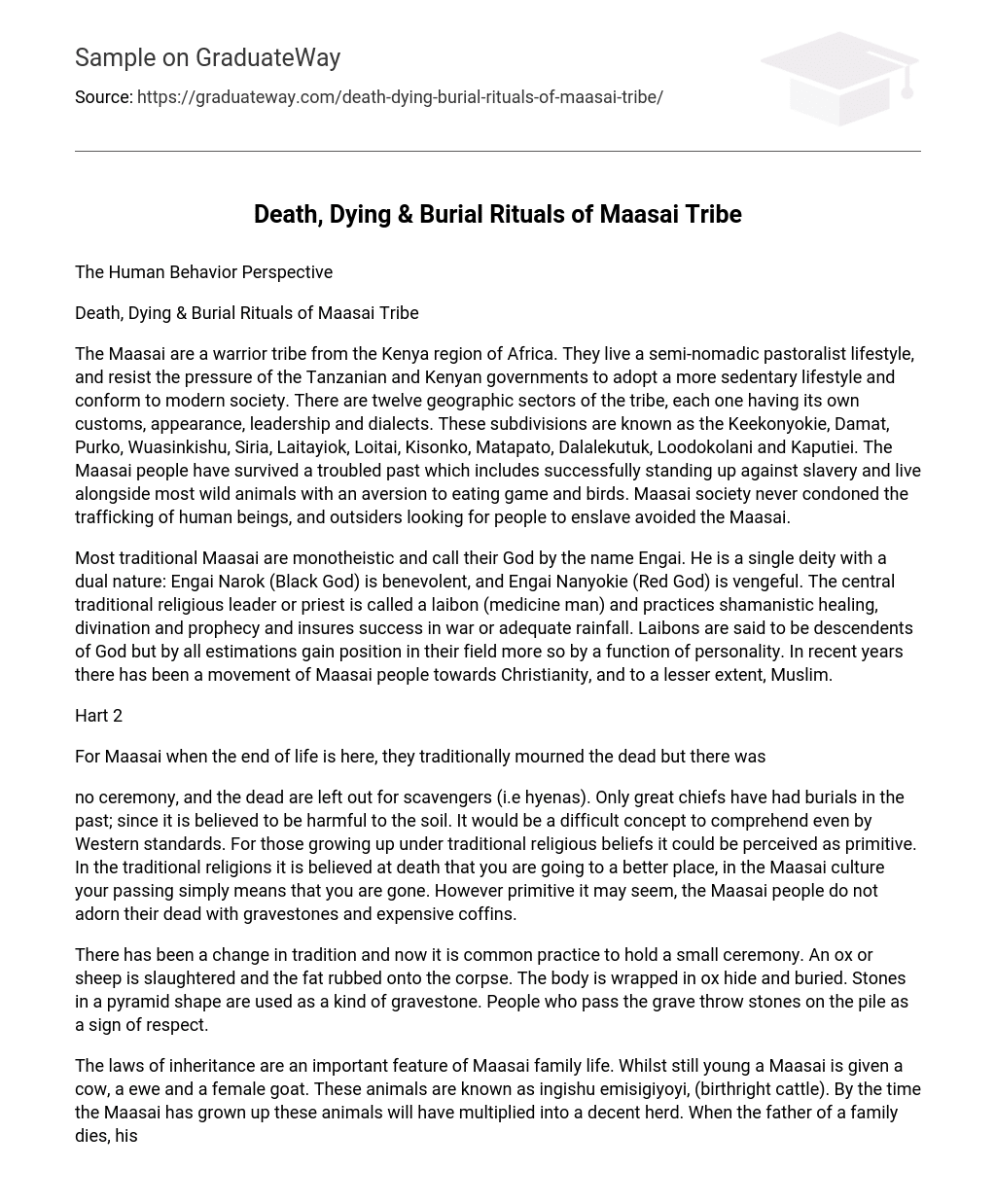The Human Behavior Perspective
Death, Dying & Burial Rituals of Maasai Tribe
The Maasai are a warrior tribe from the Kenya region of Africa. They live a semi-nomadic pastoralist lifestyle, and resist the pressure of the Tanzanian and Kenyan governments to adopt a more sedentary lifestyle and conform to modern society. There are twelve geographic sectors of the tribe, each one having its own customs, appearance, leadership and dialects. These subdivisions are known as the Keekonyokie, Damat, Purko, Wuasinkishu, Siria, Laitayiok, Loitai, Kisonko, Matapato, Dalalekutuk, Loodokolani and Kaputiei. The Maasai people have survived a troubled past which includes successfully standing up against slavery and live alongside most wild animals with an aversion to eating game and birds. Maasai society never condoned the trafficking of human beings, and outsiders looking for people to enslave avoided the Maasai.
Most traditional Maasai are monotheistic and call their God by the name Engai. He is a single deity with a dual nature: Engai Narok (Black God) is benevolent, and Engai Nanyokie (Red God) is vengeful. The central traditional religious leader or priest is called a laibon (medicine man) and practices shamanistic healing, divination and prophecy and insures success in war or adequate rainfall. Laibons are said to be descendents of God but by all estimations gain position in their field more so by a function of personality. In recent years there has been a movement of Maasai people towards Christianity, and to a lesser extent, Muslim.
Hart 2
For Maasai when the end of life is here, they traditionally mourned the dead but there was
no ceremony, and the dead are left out for scavengers (i.e hyenas). Only great chiefs have had burials in the past; since it is believed to be harmful to the soil. It would be a difficult concept to comprehend even by Western standards. For those growing up under traditional religious beliefs it could be perceived as primitive. In the traditional religions it is believed at death that you are going to a better place, in the Maasai culture your passing simply means that you are gone. However primitive it may seem, the Maasai people do not adorn their dead with gravestones and expensive coffins.
There has been a change in tradition and now it is common practice to hold a small ceremony. An ox or sheep is slaughtered and the fat rubbed onto the corpse. The body is wrapped in ox hide and buried. Stones in a pyramid shape are used as a kind of gravestone. People who pass the grave throw stones on the pile as a sign of respect.
The laws of inheritance are an important feature of Maasai family life. Whilst still young a Maasai is given a cow, a ewe and a female goat. These animals are known as ingishu emisigiyoyi, (birthright cattle). By the time the Maasai has grown up these animals will have multiplied into a decent herd. When the father of a family dies, his eldest son inherits the cattle. When a mother dies, her youngest son inherits the cattle. The middle sons take the cattle from their sisters when they marry.
There is no belief in an afterlife as mentioned before but for a parent there may be a sense akin to immortality in leaving behind a family whose very existence stems from a life that has been dedicated to care and attention. To leave no successors is to face oblivion in the fullest sense,
Hart 3
and it may be taken as a sign of having been cursed.
Hart 4
References
burial Masai. Retrieved July 10, 2009 from the World Wide Web:
http://www.masai-mara.com/mmmaa.htm
http://www.bravenewtraveler.com/2008/06/25/10-extraordinary-burial-ceremonies-from-around-the-world/
http://www.xystos.co.uk/MaasaiTribe/background.aspx
http://www.nipissingu.ca/faculty/arohap/aphome/NURS3036/resources.htm





